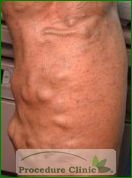
Vein problems usually result from vein insufficiency deeper in the legs where there may be problems with blood flow. The saphenous veins are major leg veins that bring blood to the heart from your feet and legs. There are valves in these saphenous veins that control blood flow toward the heart and prevent blood from refluxing back in the opposite direction. If these valves do not function correctly, blood can flow backward to the previous healthy valve, causing pressure in the vein to increase. When blood gets trapped in leg veins near the skin’s surface, they can bulge, twist, and become rope-like. These varicose veins can appear anywhere from the foot to the thigh and can cause pain, swelling, itching, numbness, cramps, or heaviness in the legs.
Vein disease is chronic and progressive. If left untreated, it can cause scarring, ulceration and permanent damage. Vein problems develop as we grow older. Almost 40 percent of women and 20 percent of men have major vein disorders by the time they’re 50 years old, although younger people can also develop them.
Vein disease includes any of the following:
- Spider veins – blue, purple, or red networks of small veins that resemble the legs of a spider, caused by pressure from incompetent saphenous veins that may cause smaller veins to fracture
- Reticular veins – veins that have become larger than the size of their valves (“incompetent veins”) and can cause discomfort, usually accompany spider veins but lie deeper and have not yet become varicose veins
- Varicose veins – enlarged, twisted, often painful leg veins caused by insufficiency in deeper veins, long periods of standing may contribute to their development
Vein insufficiency can cause problems outside the veins, including:
- Leg pain, itching, burning, aching or swelling caused by pressure caused by abnormal veins Stasis dermatitis – brown or reddish patches of skin that develop near the ankle Ulcers – resembling non-healing wounds that typically show up near the inside of the ankle but can occur anywhere on the lower leg
- Recent advancements in the treatment of varicose veins have been significant, treatment has never been better. Our comprehensive approach includes state-of-the-art Endovenous Laser Ablation (EVLA), and the micro-phlebectomy as well as sclerotherapy.
Now is the best time in the history of vein treatment. Dr. Shu is available to help you address your concerns. As an expert in office procedures and cosmetic surgeries, Dr. Shu provides a complete care for all stages of varicose vein.




